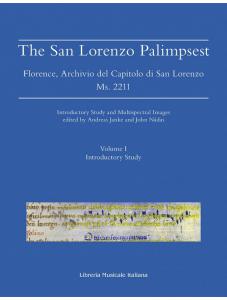The San Lorenzo Palimpsest. Florence, Archivio del Capitolo di San Lorenzo Ms. 2211 Vol. I: Introductory Study Vol. II: Multispectral images
CODICE: ISBN 8870968529 EAN 9788870968521
AUTORE/CURATORE/ARTISTA :
Edited by: Andreas Janke, John Nádas
EDITORE/PRODUTTORE : LIM Libreria Musicale Italiana
COLLANA/SERIE : Ars Nova. Nuova serie, 4
DISPONIBILITA': Esaurito
TITOLO/DENOMINAZIONE:
The San Lorenzo Palimpsest. Florence, Archivio del Capitolo di San Lorenzo Ms. 2211 Vol. I: Introductory Study Vol. II: Multispectral images
PREZZO : EUR 300,00€
CODICE :
ISBN 8870968529
EAN 9788870968521
AUTORE/CURATORE/ARTISTA :
Edited by: Andreas Janke, John Nádas
EDITORE/PRODUTTORE:
LIM Libreria Musicale Italiana
COLLANA/SERIE:
Ars Nova. Nuova serie, 4
ANNO:
2016
DISPONIBILITA':
Esaurito
CARATTERISTICHE TECNICHE:
148 + 282 pages
Paperback
cm 24 x 31,5
DESCRIZIONE:
Publisher's description:
This two-volume publication includes an introductory study and pseudo-color images of the San Lorenzo Palimpsest constituting the virtual recovery of a lost music codex, offering reconstructed readings of its original contents, making possible further scholarly study. The volume consists of 111 parchment leaves that reveal traces of its original function: in the first decades of the Quattrocento it was compiled as a sizeable collection of ars nova and early fifteenth-century polyphony. Many decades later, the volume was unbound, its leaves scraped clean of music and text, and then was assembled and bound as it began its reincarnation as an administrative ledger. The use of multispectral imaging has produced previously unimaginable results that go well beyond what was possible with previous methods of improvement. The music collection offers more than 200 songs, among them those of the Trecento repertory and including previously unknown music by the Florentines Giovanni and Piero Mazzuoli and the theorist Ugolino da Orvieto. Remarkable is the inclusion of transalpine songs and a collection of motets, which may have made their way to Florence from the Councils of Pisa and Constance and the francophile courts of Pavia and Padova. The impetus for the assemblage of such a collection, in the absence of a scholarly university tradition or courtly milieu, seems to have been the continued expression of Florentine pride in native Italian polyphonic composition joined with the cultivation of some of the most cosmopolitan repertory then available.
GENERE: Facsimili ,Libri ,



